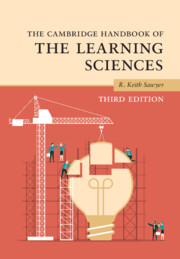Book contents
- The Cambridge Handbook of the Learning Sciences
- The Cambridge Handbook of the Learning Sciences
- Copyright page
- Contents
- Figures
- Tables
- Contributors
- Preface
- 1 An Introduction to the Learning Sciences
- Part I Foundations
- Part II Methodologies
- Part III Grounding Technology in the Learning Sciences
- Part IV Learning Together
- 19 Knowledge Building and Knowledge Creation
- 20 Computer-Supported Collaborative Learning
- 21 Arguing to Learn
- 22 Informal Learning in Museums
- Part V Learning Disciplinary Knowledge
- Part VI Moving Learning Sciences Research into the Classroom
- Index
- References
19 - Knowledge Building and Knowledge Creation
from Part IV - Learning Together
Published online by Cambridge University Press: 14 March 2022
- The Cambridge Handbook of the Learning Sciences
- The Cambridge Handbook of the Learning Sciences
- Copyright page
- Contents
- Figures
- Tables
- Contributors
- Preface
- 1 An Introduction to the Learning Sciences
- Part I Foundations
- Part II Methodologies
- Part III Grounding Technology in the Learning Sciences
- Part IV Learning Together
- 19 Knowledge Building and Knowledge Creation
- 20 Computer-Supported Collaborative Learning
- 21 Arguing to Learn
- 22 Informal Learning in Museums
- Part V Learning Disciplinary Knowledge
- Part VI Moving Learning Sciences Research into the Classroom
- Index
- References
Summary
This chapter describes a pedagogy whereby students learn how to engage in collaborative creative processes similar to professional knowledge workers. The five themes of knowledge building are (1) Community knowledge: students work together to advance the knowledge of the entire community; (2) Idea improvement: all ideas can be continually revised in an ongoing creative process; (3) Dialogue: community knowledge building involves public discourse along the lines of professional discourse in a scientific community; (4) Constructive use of authoritative information: students always need to work with authoritative information, even while they are creating new knowledge. New knowledge creation must be coherent with what is already known; (5) Epistemic artifacts: knowledge building is more effective if learners create externally sharable things. The chapter describes the authors’ influential Knowledge Forum application, one of the first networked collaborative idea-generation tools.
Keywords
- Type
- Chapter
- Information
- The Cambridge Handbook of the Learning Sciences , pp. 385 - 405Publisher: Cambridge University PressPrint publication year: 2022
References
- 3
- Cited by



